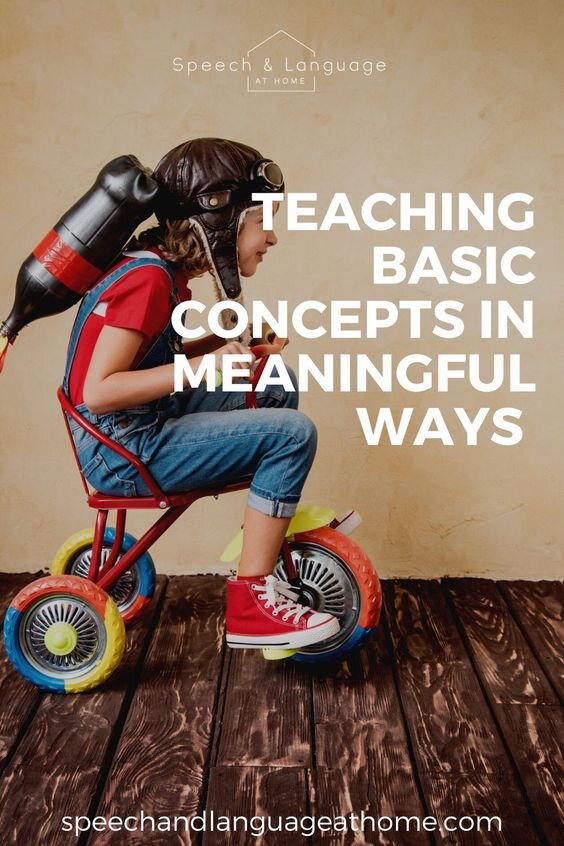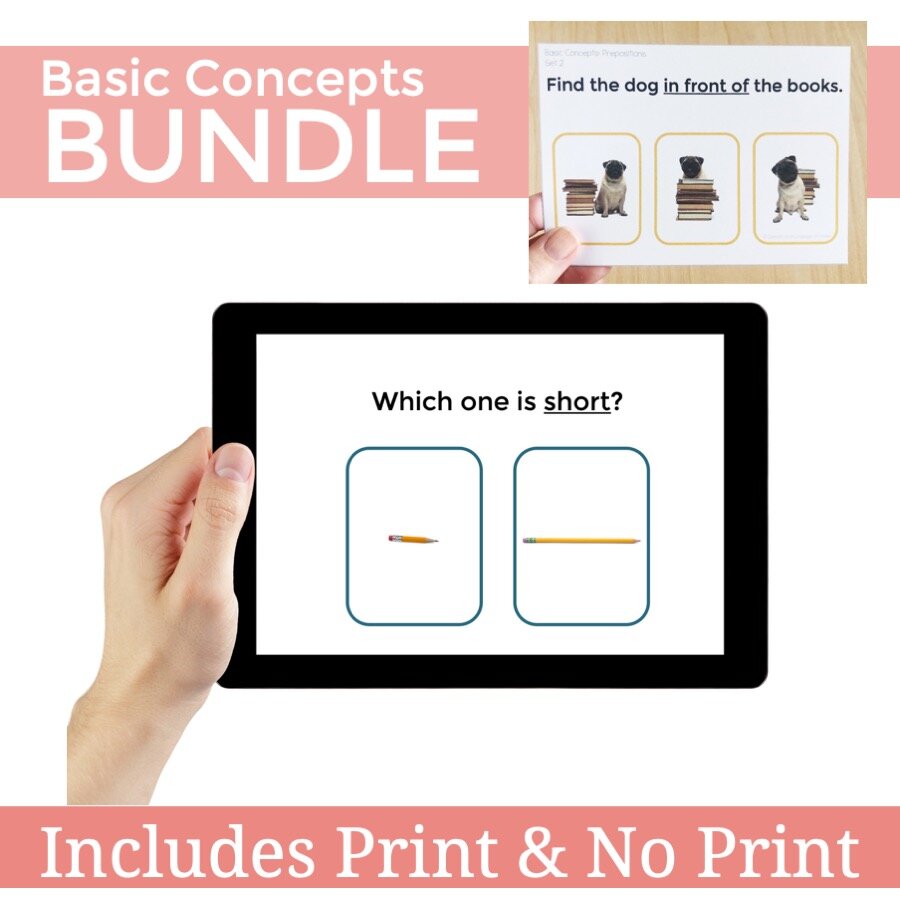Make Basic Concepts Fun With These Simple Activities
Today let’s chat about basic concepts: what they are, why they’re important, and how to teach them using fun but simple activities.
When I worked as a speech therapist, one of my favorite goals to write and work towards involved basic concepts
Why?
Because goals around basic concepts are measurable and functional. They lend themselves well to creative, fun, and play-based activities, and they can easily be altered to target receptive language, expressive language, or both
But it’s not all fun and games! Basic concepts can be tricky to teach. They are inherently abstract and conceptual. And the words we use to represent these concepts are both abundant and full of nuance.
Whether you’re excited or hesitant to jump into the deep end of the basic concepts pool, I’ve got some tips for you.
What are Basic Concepts and What Makes Them Important?
Words that describe the physical world are generally considered “basic concepts,” and they’re incredibly important building blocks for language development and early education. (1)
The four basic concept categories involve location, quantity, time, and quality. Although the words used to describe concepts grow in complexity as a child develops, the categories of concepts remain the same!
Research tells us that basic concepts are important for academic achievement. (2) They support learning in various subject areas: math, literacy, and more.
Everyday activities –– in the classroom or home –– involve these concepts. A single direction might even include words from each of the four categories. If your little one struggles with basic concepts, he or she might miss important information throughout the day.
The Basics of Teaching Basic Concepts
Studies show that basic concepts are best taught collaboratively. This means that, ideally, a child’s teacher, speech therapist, parent, and any other caregivers will work together to teach concepts. (2)
Incorporating instruction of basic concepts into the school curriculum (across subjects) is helpful to master these concepts. Don’t forget to also use opportunities for learning that come up naturally within daily life! This will help to reinforce your child’s skills and promote generalization. (2)
Especially because basic concepts are so abstract, it’s helpful to use visual cues to support learning. Picture cards are an easy way to provide a slightly more concrete representation of the ideas. Grab the Basic Concepts Picture Card Set from Speech and Language at Home. You can always provide more support –– hand-over-hand guidance, modeling, etc. –– or less, as needed. Help your child feel successful!
Breaking Down the Categories (Plus Simple Activities!)
While developing a curriculum around basic concepts, it’s important to review the concepts –– and the words within each –– that we expect children to learn. Then comes the fun part: creating engaging but simple activities to target them!
Spatial Concepts
Words describing location, position, and direction all fall within the domain of spatial concepts. And there are many! A child will begin with the early developing words: in and on, up and down. As his or her language and cognitive skills grow, more complex position words appear (e.g., under, over, between, on top, above, below, next to, around, etc.). Words to describe location, such as near, far, and close, arrive later, as do directional words like forward, backward, right, left, north, south, east, and west.
How to teach them: Dollhouses, play barns, and cardboard boxes are fun ways to explore location, position, and direction.
Grab some people or animal figurines and work on following directions! Show a picture card depicting a target position, provide a figurine, and give a verbal direction (e.g., “Put the horse in the barn” or “Put the chicken on the barn”). Continue the task until all the figurines are in the appropriate places.
Here’s an example using “on” with play food.
Temporal Concepts
Words in this category describe time. Temporal words like soon and later come earliest, followed by words such as before, after, first, next, second, and last. Later, kids will develop an understanding of calendar words: yesterday, tomorrow, week, month, year, etc
How to teach them: I love to teach early temporal concepts with food! Building an ice cream cone, sandwich, or hamburger is a fun way to engage your child while learning about temporal sequences.
Grab pretend food, real food, or pictures of food. Show a picture card depicting a target temporal concept (e.g., first) and give a verbal direction (e.g., “First I want a scoop of chocolate ice cream and then I want a scoop of vanilla” or “After putting on the peanut butter and jelly, get another slice of bread”). Continue the task until the food item is complete!
Quantity Concepts
To describe the number or amount of something, we use quantity words! Early developing words in this category include one, more, another, and all. Later, a child will begin to understand words to indicate a precise quantity (e.g., three, twenty-six, zero, etc.), general quantity (many, some, few, a lot, several, a couple, none), and relational quantity (e.g., fewer, more, less, most, least)
How to teach them: Art and craft projects set the stage perfectly for teaching quantity.
Maybe this December you’re making a Christmas tree out of felt and beads or a menorah for Hannukah out of construction paper and popsicle sticks. Build in quantity words as you direct the craft. Show a picture card depicting a target quantity concept and give a verbal direction (e.g., “Put lots of beads on the tree,” “Put one star on top,” or “Get all the popsicle sticks and line them up”). Keep going until the project is all done.
Quality Concepts
Quality concepts describe all the other aspects of something physical: its size, shape, color, texture, or state. There are an incredible number of words to target within this category, but the concepts tend to be more concrete and observable than those in other categories. Early words include simple descriptors like big and small, colors, stop and go, and happy and sad. Later, more nuanced attributes develop.
How to teach them: For children who are able, play a game of memory! Not only is this a fun way to learn about quality concepts, it teaches opposites and targets a child’s executive functioning skills.
Grab a stack of picture cards depicting pairs of opposites; there are lots of choices in the bundle! You’ll need at least two pairs. Be sure to keep your child’s skill level in mind. Conduct a “teach session” prior to beginning the memory game. Use items around your house to reinforce the meaning of words (e.g., hot and cold, on and off, loud and quiet, open and closed, wet and dry, etc.). Next, lay all the picture cards face-down on a flat surface. Take turns as you attempt to find the opposites, picking two cards each turn. Act out the words as you encounter them for bonus learning!
Limited on Time? Make Your Activities All-Inclusive
The more familiar you get with basic concepts, the more readily you’ll be able to target words within all the categories in a single, simple activity.
That’s the beauty of basic concepts: They’re everywhere and always relevant.
Sources
For more ideas on how you can teach basic concepts to your child at home check out these resources.






